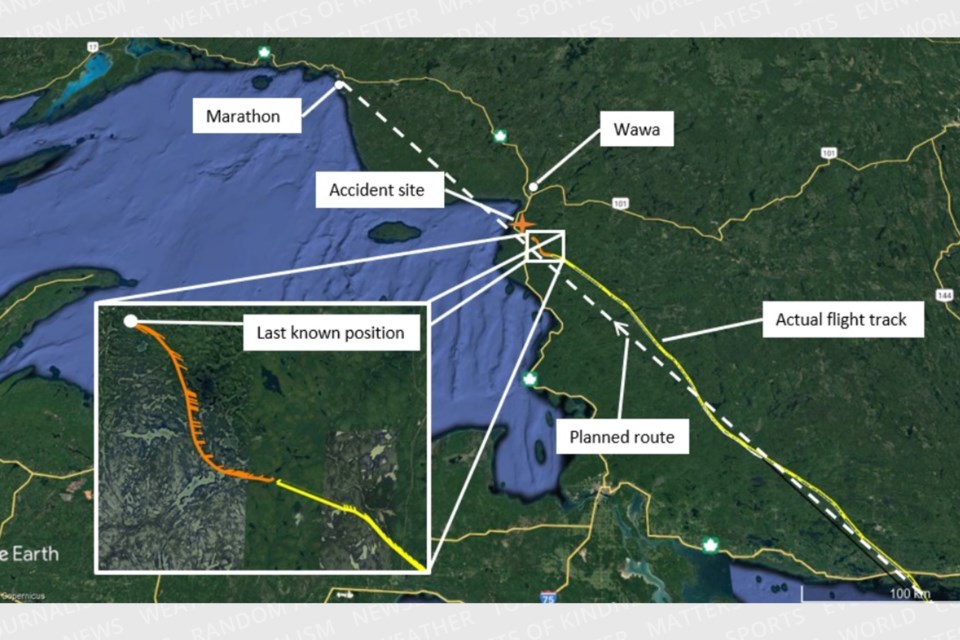The Transportation Safety Board of Canada (TSB) has released its investigation report into the fatal plane crash that killed two men near Wawa this past April.
The investigation confirms that a privately registered Piper PA24-250 (Comanche) departed from Delhi, Ont., at 3:43 p.m. in sufficient weather conditions on its way to Marathon on April 14, 2022.
A video of the onboard instrumentation was taken around one hour after takeoff, which showed the aircraft was still flying in appropriate weather conditions, but dense clouds could be seen west of the flight plan.
The plane changed its heading slightly towards the west and was on track towards Marathon just before flying over Manitoulin Island.
According to the automatic dependent surveillance-broadcast (ADS-B) data collected after the incident, the aircraft was flying towards Marathon at 5:58 p.m., but was beginning to show a higher frequency of heading changes.
ADS-B information was lost at 6:03 p.m. when the plane was around 14 nautical miles, or 26 kilometres, south of the Wawa Municipal Airport as weather conditions began to worsen.
The Joint Rescue Coordination Centre (JRCC) in Trenton, Ont. was informed the flight was overdue, and they soon tasked a Canadian Armed Forces CH-146 Griffon helicopter and CC-130H Hercules airplane to begin a visual and electronic search along the intended route from Manitoulin to Marathon.
Poor weather conditions and reduced visibility made the search challenging, and after 10 days of an extensive search and rescue effort led by the JRCC, the mission was called off on Apr. 24 and the OPP took over as a missing persons case.
On May 21, a helicopter operator conducting a private search found plane parts in an open swampy area, and an OPP helicopter flying nearby landed at the site and confirmed it was from the missing aircraft.
Discovered in a mountainous and densely wooded area, the crash site was around 11 km northwest of the plane’s last known position.
At the time, SooToday learned that family members of one of the pilots, Brian Slingerland, were on board the private helicopter that initially discovered parts of the wreckage.
Both Slingerland and his friend John Fehr were killed in the crash, and the aircraft was destroyed.
The plane had accumulated nearly 4,400 total hours since its last inspection in April 2021.
Impact and wreckage information:
The wreckage was found in a mountainous and densely wooded area 37 days after the aircraft went missing. The right wing’s outboard section had separated from the fuselage after an impact with a tree and was found approximately 170 m northeast of the main wreckage. The aircraft collided with terrain in an almost-inverted, vertical nose-down attitude.
The landing gear was found in the down and locked position and the flaps were still in the retracted position. The flight controls were examined to the extent possible and there was no sign of pre-impact discrepancies. The damage caused by the propeller to the surrounding trees is consistent with the engine developing power before the impact, although the amount of power could not be determined. Both occupants were found inside the wreckage.
The aircraft’s GPS (global positioning system) and ADS-B instruments were recovered and sent to the TSB Engineering Laboratory in Ottawa, Ontario; however, it was not possible to extract any data from them due to the damage caused by the impact.
The 406 MHz ELT and the aircraft’s main battery were found on the ground near the wreckage and had likely been ejected from the aircraft at impact, damaging internal and external components. The ELT was in the ARM position and the antenna cable was torn near the ELT connector, preventing signal transmission beyond a short distance. Further examination conducted on the ELT determined the following:
- The contact lead of the internal G-switch was damaged during impact, which prevented it from functioning properly.
- The mode switch contacts were damaged from the impact such that the ELT could not be manually switched to the ON position and did not activate automatically when in the ARM position.
- The ELT battery pack was sufficiently charged to transmit an emergency signal.



